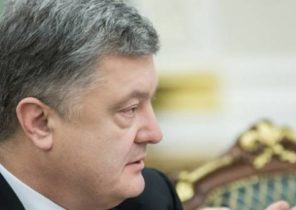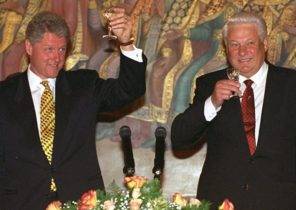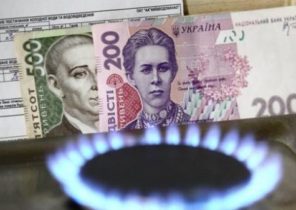The collapse of oil prices in early March, which occurred after Russia withdrew from the transaction of OPEC, became a catastrophe for it, because this country is still increasing its budget, mainly due to energy exports. But then something strange happened: oil prices as of may 7 fell by 56% since the beginning of the year, and the ruble over the same time period lost 19 percent of its value.
The ruble somehow manages to float in the air like some Tibetan monk, although the soil in oil prices have left him from under his feet.
The ruble has long been tied to the price of oil, and they had walked hand in hand. The situation changed when the Ministry of Finance introduced the budget rule (it is the same — the fiscal rule), according to which any additional revenues from oil exports are routed automatically to the national welfare Fund, if oil prices exceed $ 42 per barrel.
This rule has led to the fact that Russia, as at 1 April accumulated in the reserve Fund of 12 trillion rubles (163,4 billion), accounting for 11% of GDP. This helped to reduce inflation to post-Soviet lows, but most importantly, this rule broke the reference value of the ruble to the price of oil.
Now the situation has changed. When oil prices fell below the thresholds of $ 42 per barrel, the fiscal rule has ceased to operate and has lost all meaning. In the new bundle oil prices — the value of the ruble should resume.
The average exchange rate in 2018 was 62.7 per dollar, and the average price of oil was equal to 70.8 dollar. In 2019 the oil price fell by 11.4% to the value of 62,7 USD per barrel, but the ruble exchange rate decreased by much less — only 3.2% to 64.7 rubles per dollar. This has become possible mainly due to the inertial effect of the budget rules.
However, in the first four months of 2020, was much more dramatic changes. The average price of oil fell by a third (31,2%) to 43.1 percent (in January and February it cost of 63.7 and 55.7 per dollar, respectively), while the average rate of the ruble against the dollar over this period amounted to 68,7, that is, the exchange rate decline is only 6%.
In March and April, when the crisis was in full swing, the average price of oil dropped to 32 and 21.2 per dollar, respectively, that is, another quarter (25.8 per cent), and then there was another fall of one-third (33,6%). However, the value of the ruble in the last two months amounted to 73,7 and 75.2 per dollar, respectively. That is, the March decline rate was 7.3% and the APR is only 1.9%.
Not to say that the ruble is generally not affected in the ongoing crisis, which is considered the most serious in 1998, when there was a complete collapse of the Russian financial system. But why the ruble in the Russian oil-dependent economy so easily overcomes the force of gravity?
The Russian Central Bank to the rescue
One of the reasons Russia must survive the current crisis with fewer losses than other emerging markets, is that the head of the Central Bank of the Russian Federation Elvira Nabiullina in response to the oil shock of 2014, when oil prices collapsed the first time, let the ruble float freely.
The Kremlin is fixated on how to save the Russian foreign exchange reserves, which amounted on April 1, 569,7 billion dollars. The reason is that he considers them a strategic asset. The size of Russian reserves suggests that the country can not afraid of sanctions, because even if the US imposes more stringent punitive measures, Moscow will be able to get out of a difficult situation for the money. At the same time she will not have to borrow on international capital markets, which make it vulnerable to sanctions pressure.
CBR has demonstrated its willingness to ensure that the exchange rate will take the brunt of the oil shock. Unlike many other countries, it does not protect the ruble, but seeks to preserve foreign currency reserves. Turkey, for example, in the fall of its currency rushed to reinforce it. Moreover, money from the national welfare Fund will be used to protect the ruble because they have only one goal: to support the budget and to cover the expected in this year’s Federal budget deficit amounting to 3-4 trillion rubles.
During the fall of oil prices in 2014, the ruble has fallen, too, and much more. Before the crisis, the dollar a few years cost 35 rubles, but during the collapse of the exchange rate suddenly fell greatly, and the dollar began to give 80 rubles.
Investors panicked, started to call the Governor, incompetent and reckless, but she now and then refused to spend the reserves for the defence of the course which it was impossible to defend.
The crisis began in October, and the peak came in December. 16 Dec 2014, the CBR finally announced an emergency rate to 17% to shore up rodivshuyusya currency.
Now the ruble lost value is much less than in those months in 2014. For this reason, investors and the population met this crisis much calmer. It also means that compared to 2014, the economic damage from the crisis for the currency will be much softer.
What is striking is that in contrast to 2014, when CB went for the largest simultaneous rate increase in Russia’s history, at the regular April meeting this year, the Bank aggressively cut interest rates by 50 basis points in an attempt to make the economy an adrenaline shot to enhance growth.
The April decrease is a reflection of a completely different world. Usually in times of crisis, Central banks in emerging markets are forced to raise rates to protect their currencies, as did Russia in 2014. And the economy with the developed market lowers rates, stimulating growth. The first thing that made the us Federal reserve in April, it cut the US base rate to zero.
Nabiullina in April had to make a difficult decision because she had the choice and could go in either of two directions: to cut rates to promote growth or raise them to avoid the inflation caused by the devaluation of the ruble. Proof of its effective control of the Russian Central Bank in 2013 was the fact that she made a choice in favor of the second option, lowering the rate as in developed markets in response to unpleasant external shocks.
In defense of the ruble
At the end of 2014, the Central Bank of the Russian Federation refused “rouble exchange corridor”. This mechanism, which operated for almost 20 years and forced the Central Bank to manage the exchange rate, preventing its rapid devaluation.
This year, the Russian reserves declined from its peak of 580 billion to $ 570 billion at the beginning of April. But mostly, this decrease is attributable to a reassessment of the effects of those assets that CBR uses to store Russian monetary reserves. The Central Bank last month spent a total of about two billion dollars in real money on its interventions to smooth the fall of the ruble exchange rate, which is very little.
The true amazement is the fact that Russian reserves this year even increased by seven billion dollars as of January 1, their volume was 562,3 billion dollars. The volume of these reserves has been decreasing since 570,3 billion dollars in February to 563,4 billion in March, but in April they somehow miraculously rose again, making today 569,7 billion dollars.
CBR will not touch the Russian foreign exchange reserves to protect the ruble exchange rate and will not be able to use the money from the national welfare Fund, because technically it is the responsibility of the Ministry of Finance. But the government found a loophole to get more dollars for the Central Bank, which could be used to protect the ruble. This explains why in the last two months the ruble refutes all the laws of gravity.
11 April, the Central Bank hastily concluded a sale of 50% (+1 share) of the shares of the savings Bank the Ministry of Finance of 2.14 trillion rubles (29,1 billion).
The change of ownership in one fell swoop managed to solve several problems. First, the Central Bank was in a very uncomfortable position of being the regulator of the banking sector and at the same time owning the largest Bank in this sector. Now the owner of the savings Bank is the Ministry of Finance, as it should be.
Secondly, thanks to this deal, the budget gets more money. Sberbank is the most profitable Bank in the sector, and he recently promised to raise dividend payout to 50% of their income, since the state increasingly uses dividends and not tax to get the best profit of the companies. But the Central Bank of the Russian Federation regularly held these payments, keeping them on their balance sheets. Now all the dividends of the savings Bank will go directly into the budget.
Third, this deal gives the Central Bank a loophole to use money from the national welfare Fund as well as money that can be spent in the market short-term debt obligations for the protection of the ruble. The Ministry of Finance paid for the transaction with funds from the national welfare Fund, which is now reduced to about nine trillion rubles.
The last point is very important, because the alternative is for the Central Bank to maintain the ruble was another increase in rates, and it would kill all the growth of the Russian economy, which was to be expected during recovery from the April fall.
It is still unclear how the CBR will use the money. But those 29 billion dollars that he got, should be enough to defend the ruble in September. The government hopes that by the time the situation stabiliziruemost, and oil prices will recover sufficiently in order to be able to ease the strain on public finances, especially after prisoner 13 APR deal on production cuts OPEC++ where oil production will decline by 9.7 million barrels per day.
“The Central Bank will gradually sell [$29 billion], making it to the end of September, if the price of Urals brand will remain below $ 25, wrote in a recent article, the editor RBC on economy Ivan Tkachev. — Since the beginning of these interventions, the price of Urals brand never exceeded a threshold value, and the Central Bank in April, has sold more than two billion dollars. More Russian oil will deviate from the 25 dollars, the more currency to sell to the Central Bank. Thus, it essentially compensates for the shortage of export revenues, supplying the domestic market with foreign currency, if the price of Urals was equal to 25 dollars”.
Through the sale of currency of the Central Bank automatically defends the rouble against excessive depreciation in the period of decline in oil prices and gives the government extra time in five months that the worst effects of the crisis waned.
At an oil price of 25 dollars per barrel a fair ruble exchange rate is 75-76 rubles per dollar, said Tkachev. The price of Brent may 9 was 30.97 dollar, and the ruble 73,4, that is quite a bit better than the lower values of estimates and projections Tkachev on oil prices and exchange rate.
The money of the savings Bank is not the only resource, abandoned by the state to protect the ruble. In addition to the operations of the Central Bank of the Russian Federation, the Ministry of Finance itself and sells currency on the monetary market. The Central Bank collects statistical data for both mechanisms, as it in both cases is the agent for the sale of currency, said Tkachev.
“In contrast to the irregular sales of the Central Bank, Ministry of Finance operation are recorded in advance, a month before their implementation. In April, the daily volume of currency sales was equivalent to 3.5 billion rubles (about $ 46 million). But since March 10, when the Central Bank began foreign exchange intervention in the interest of the Ministry of Finance, and until April 22 on both channels were sold over five billion dollars”, — said Tkachev.
According to the budget rule, the sale of dollars because oil prices are lower level $ 42 per barrel. However, on 8 may, the Central Bank has issued informal “support budget rule”. He announced that he would intervene in the market of foreign exchange transactions, when the price of Russian Urals brand (usually it is two dollars cheaper than Brent) drop below $ 25. This means that the Central Bank will in addition sell for 0.5-1.5 billion dollars on the open market in case of decrease in oil Urals price of five dollars per barrel, below the minimum threshold. This assessment gives the analysts of “VTB Capital”.
“This is the main reason why the ruble goes down with oil prices in the period of their dramatic decline,” says Tkachev.







